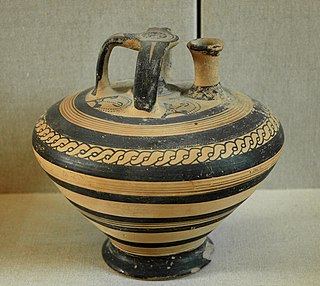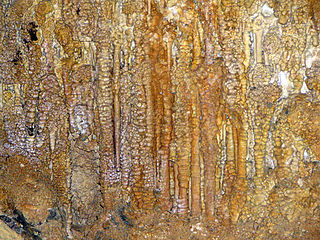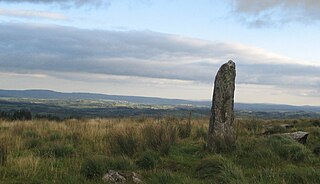
An archaeological site is a place in which evidence of past activity is preserved, and which has been, or may be, investigated using the discipline of archaeology and represents a part of the archaeological record. Sites may range from those with few or no remains visible above ground, to buildings and other structures still in use.

A megalith is a large stone that has been used to construct a structure or monument, either alone or together with other stones. The word megalithic describes structures made of such large stones without the use of mortar or concrete, representing periods of prehistory characterised by such constructions. For later periods, the word monolith, with an overlapping meaning, is more likely to be used.

An artifact, or artefact, is something made or given shape by humans, such as a tool or a work of art, especially an object of archaeological interest.

The Coldrum Long Barrow, also known as the Coldrum Stones and the Adscombe Stones, is a chambered long barrow located near the village of Trottiscliffe in the south-eastern English county of Kent. Probably constructed in the fourth millennium BCE, during Britain's Early Neolithic period, today it survives only in a state of ruin.

In archaeology, rock art is human-made markings placed on natural stone; it is largely synonymous with parietal art. A global phenomenon, rock art is found in many culturally diverse regions of the world. It has been produced in many contexts throughout human history, although the majority of rock art that has been ethnographically recorded has been produced as a part of ritual. Such artworks are often divided into three forms: petroglyphs, which are carved into the rock surface, pictographs, which are painted onto the surface, and earth figures, formed on the ground. The oldest known rock art dates from the Upper Palaeolithic period, having been found in Europe, Australia, Asia and Africa. Archaeologists studying these artworks believe that they likely had magico-religious significance.

The 'Bosnian pyramid complex' is a pseudoarchaeological notion to explain the formation of a cluster of natural hills in central Bosnia and Herzegovina. Since 2005, Semir Osmanagić, also known as Sam Osmanagich, a Bosnian businessman now based in Houston, Texas, has claimed that these hills are the largest human-made ancient pyramids on Earth. His claims have been overwhelmingly refuted by scientists but he has proceeded to promote the area as a tourist attraction.

The dolmens of Jersey are neolithic sites, including dolmens, in Jersey. They range over a wide period, from around 4800 BC to 2250 BC, these dates covering the periods roughly designated as Neolithic, or “new stone age”, to Chalcolithic, or “copper age”.

Parc Cwm long cairn, also known as Parc le Breos burial chamber, is a partly restored Neolithic chambered tomb, identified in 1937 as a Severn-Cotswold type of chambered long barrow. The cromlech, a megalithic burial chamber, was built around 5850 years before present (BP), during the early Neolithic. It is about seven 1⁄2 miles (12 km) west south–west of Swansea, Wales, in what is now known as Coed y Parc Cwm at Parc le Breos, on the Gower Peninsula.

Risovača Cave, is situated at the very entrance of the town of Aranđelovac in central Serbia around 17 m (56 ft) above the Kubršnica river valley. It is one of the most important archaeological sites of the Palaeolithic in Serbia besides the Gradac Cave near Kragujevac. Its discovery confirmed the assumed existence of the Paleolithic culture south of the Sava-Danube line and provided new information on the life of prehistoric humans in Europe.
The Palace Site is a ca. 7,000-year-old archeological site in Des Moines, Iowa with evidence for some of the oldest houses west of the Mississippi valley and the oldest human burial in Iowa. Since 2011, the site has yielded 6,000 or more artifacts, as well as the remains of two humans, a woman and an infant, that are the oldest human bones to be found in the state. A spear point found beneath the woman's lower back appears to have been intentionally placed there during burial. Also found in the grave were a small polished stone, a flint chip from stone tool making, and wood charcoal. The OSA Burial Protection Program is legally responsible for investigating, preserving, and re-interring ancient human remains.
Sisyphus Shelter is an archaeological site that was uncovered in Colorado when the Colorado Department of Highways was working on I-70. The excavation of this site became a joint project between the Colorado Department of Highways and the Bureau of Land Management. Fieldwork on the site was completed in 1980. Archaeologists John Gooding and Wm. Lane Shields as well as many others completed the excavation and prepared a comprehensive site report. Over the course of the fieldwork on Sisyphus Shelter, twenty-six features of human origin were discovered as well as numerous stone artifacts and two perishable items. The artifacts appeared to be all Late Archaic in origin. Dating indicated a range of occupations from modern times to 4400 B.P. being the oldest sample. Gooding and Shields (1985) suggest that the occupations of the shelter were not consistent and affected by seasonal changes.
The Anzick Site (24PA506) in Park County, Montana, United States, is the only known Clovis burial site in the New World.

The Wotanstein, also known as 'Wodanstein' or earlier on 'Malstein', is a small megalith or menhir situated close to the village of Maden, Schwalm-Eder-Kreis, Hesse, Germany.

The Mladeč caves are a cave complex in the Czech Republic situated to the west of the village of Mladeč in the Litovelské Pomoraví Protected Landscape Area.
Dewil Valley, located in the northernmost part of Palawan, an island province of the Philippines that is located in the MIMAROPA region, is an archaeological site composed of thousands of artifacts and features. According to the University of the Philippines Archaeological Studies Program, or UP-ASP, the closest settlement can be found in New Ibajay, which is covered by the town capital of El Nido, which is located around 9 km (5.6 mi) south-east of Dewil Valley. Physically it measures around 7 km (4.3 mi) long, and 4 km (2.5 mi) wide. It is in this place which the Ille Cave, one of the main archaeological sites, can be found. It is actually a network of 3 cave mouths located at its base. It has been discovered that this site in particular has been used and occupied by humans over multiple time periods.

Archaeology is promoted in Jersey by the Société Jersiaise and by Jersey Heritage. Promotion in the Bailiwick of Guernsey being undertaken by La Société Guernesiaise, Guernsey Museums, the Alderney Society with World War II work also undertaken by Festung Guernsey.
This page is a glossary of archaeology, the study of the human past from material remains.

















